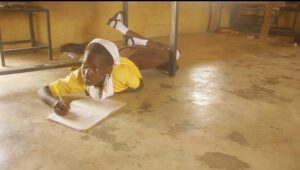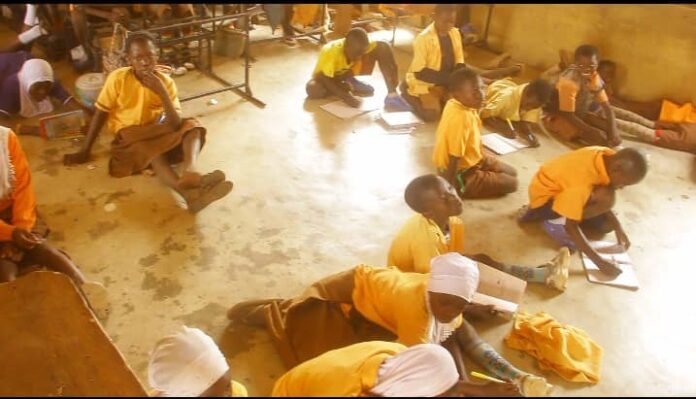Ghana’s basic education subsector has the largest infrastructure deficits, with over one million desks shortage, and over 5,000 schools under trees, sheds and dilapidated structures.
This is despite the delivery of basic education as one of the top priorities of successive governments in the country.
Several policies and programmes have been introduced to promote access and quality in the delivery of basic education.

The desk situation in schools has led to learners adopting improper sitting postures during lessons which subsequently result in postural overload and consequently affect their performance in classroom activities such as writing and reading.
Regional and district disaggregation of desk data reveals how profound the challenge is in some parts of Ghana.

While the national desk shortage is 40 per cent, all the six (6) regions in the northern part of Ghana; Savannah, Northern, North-East, Upper West, Upper East, and Bono East and Oti regions had ratios above the national rate.

The Gushegu Municipality in the Northern Region is one of the hardest hit, with over sixty percent deficit.
Primary School children have to sit in fours on dual desk with many sitting on the floor or lying on their bellies to take lessons.

At the Junior High level, the situation is even worse.
Teachers complain that the situation is frustrating and impeding academic work.
“My school has over 768 children from KG to primary six, but our furniture is only 40 in number and even with that some are broken and so, majority of the children sit on the floor” Mahama Hafiz, Headteacher Maazijung M/A primary said.
“The children are not comfortable and so most of them don’t come to school again. Their parents cannot also afford to provide them with the furniture and so we are just managing here,” he added.
Recent data available through the Ministry of Education’s (MoE) Education Management Information System (EMIS) suggests that as of 2021, 50 per cent (596,949) KG pupils, 40 per cent (1,308,479) primary pupils and 30 per cent (425,465) JHS pupils did not have seating and writing places, bringing the total to 2,330,893, representing 40 per cent of basic school pupils.
The Gushegu Municipal Director of Education Ahmed Teejani Hassan is worried the situation is affecting enrollment.
“There is virtually no furniture in most schools in the municipality and so, the gap is huge and impacting negatively on enrollment and performance,“ he explained.
In 2021, 2022 and 2023, the Ghana Education Trust Fund (GETFund) allocated GHC 56.3 million, GHC 201 million and GHC 166.9 million respectively for infrastructure development at that level.
On average, these amounts represent about 30 per cent of the total GETFund allocation to infrastructure.
Out of these allocations, GHC11.5 million, GHC 30 million and GHC 15 million were allocated for the supply of furniture in 2021, 2022 and 2023 respectively.
Following the distribution of over 13,000 desks to basic schools by GETFund, the Gushegu municipality received 180 dual desks, with 90 each supplied to the lower and upper primary levels respectively. This figure is woefully inadequate.
“We recently received some 180 desk from GETFUND, but looking at the number of schools we have that is 103 primary schools and 23 Junior High Schools some got only two out of the number and the populations are huge.”
He appealed to benevolent individuals and organizations to come to their aid.
Owing to the scary situation in the Northern Region, the news team traveled to the Kintampo North Municipality in the Bono East region.
Here, the situation is even dire as most school children have been compelled to buy their own tables and chairs.
Pupils of Jato Basic School and Gurmaline Islamic Basic School, have to buy their own tables and chairs as the school battles inadequate furniture.
Some of the pupils whose parents cannot afford furniture, have to stand or sit on windows to write.
Razak Imoro, is a form two pupil of the Gurmaline Islamic Basic School.
“I stand here to take my lessons every day and place my book on the wall to write because my parents cannot afford 2GHC00 to buy me a table and chair, since the school doesn’t have enough. So I have been standing and writing for the past two years.”
The Kintampo North Municipal Director of Education, Sylvester Opoku is worried about the gap.
“I must admit we are suffering here with furniture issues. Even town schools do not have enough furniture, so your guess is as good as mine in the rural schools. Some of them have not received a single desk for over five years and counting and that’s serious, “he bemoaned.
President Akufo-Addo in his latest State of the Nation Address in February this year while touching on education, noted that a lot of resources have gone into improving education infrastructure in the country.
“Mr Speaker, a lot of resources have gone into the provision of infrastructure at all levels of the education system. But a lot remains to be done. Many basic schools require more adequate classrooms and furniture, and the environment in some of these schools can be made more suitable for learning and teaching,” the President said.
For Education watchers like the Africa Education Watch (Eduwatch), awarding new school building contracts without including the provision of desk and low financial capacity of District Assemblies to provide school infrastructure are among major setbacks in addressing the policy gaps.
More commitments would have to be made to fully address this challenge. Until then children in most basic schools will continue to suffer the consequences.
By Christopher Amoako












